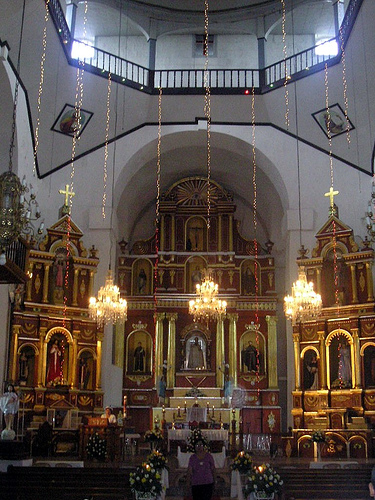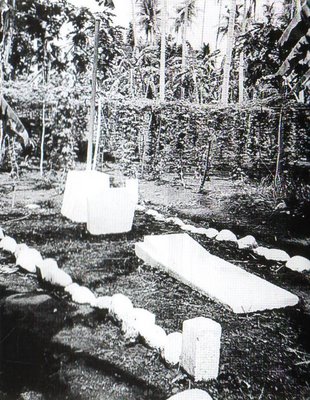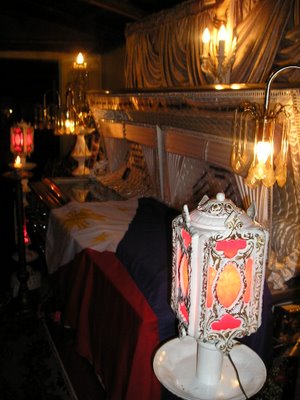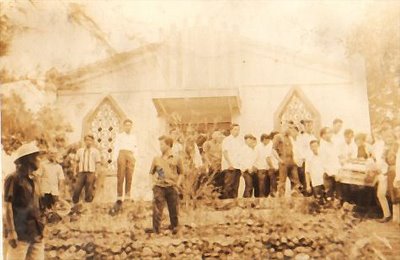The first simbahans built in the Philippines were made of local light materials and were called as kamarins or toclong. The massive stone simbahans were later built because of the constant threat from fires and typhoons. These solid structures are usually in the Romanesque, Gothic, Renaissance, and Baroque styles or a combination of these influences. The following is a brief description of these styles from Norma Alarcon’s “Philippine Architecture During the Pre-Spanish and Spanish Periods:
The ROMANESQUE style features square, octagonal or circular bell towers; shallow wall buttresses; jambs or “orders” in door and window openings; a rose or wheel window over the principal door; and arcades with circular columns. An example of this style is Guadalupe’s Church of Nuestra Senora de Gracia --- the first ermita to be established in the Philippines and later ecclesiastically accepted by the Augustinians in 1601 to serve mainly as a rest house for its missionary priests. The first makeshift parochial buildings were built between 1601 and 1605. There are no records on who initiated the construction of the stone church that was finished during the term of Fr. Eustaquio Ortiz (OSA) probably in 1629 or 1630. It was damaged during the 1645 and 1658 earthquakes. Repairs and improvements to the church were made from 1659 until 1753 but was again damaged during the 1754 earthquake, and ransacked by the invading British in 1762. Earthquakes in 1850 and 1863 inflicted more damage to the church and finally, the building collapsed during the 1880 earthquake during which the original image of the Nuestra Senora de Guadalupe was lost in the rubble. Fr. Jose Corugedo (OSA) supervised the rebuilding of the church in 1882. The church was occupied by Filipino troops led by Gen. Pio del Pilar in 1898. It was razed by fire in 1899 during early skirmishes between Filipino and American soldiers. During World War II, it was turned into a garrison by the invading Japanese and was later demolished after the war to provide materials for the reconstruction of the Manila Cathedral. The ruins were again handed to the Augustinians in 1970 who had the church rebuilt until 1972 with the Nuestra Senora de Gracia as the new patron. Further restoration work was conducted from 1983 until 1995.

Walls supported by flying buttresses, openings spanned by pointed arches, the frequent use of piers combined with shafts, and tall flanking towers at the façade are the features of the GOTHIC style that is best exemplified by the Church of San Sebastian in Manila. It is the first all-iron church in the world, the first iron structure in Asia and the second in the world after the Eiffel Tower, and the first pre-fabricated structure to be put up in the Philippines. It was designed by Engr. Don Genaro Palcios y Guerra and required 52 tons of imported steel from Belgium. The construction of the church --- described as a model of Christian art --- was supervised successively by Fr. Gregorio Serma (OAR), Fr. Toribio Minguella (OAR), Fr. Bernardo Muro (OAR), and Fr. Francisco Moreno (OAR) until its completion in 1890. The first structure preceding this steel edifice was built of light materials probably by Fr. Rodrigo de San Miguel (OAR) in 1621. The Chinese burned this in 1651 and a new brick church was built. This suffered a cycle of destruction and rebuilding during the earthquakes of 1859, 1863, and 1880 until Fr. Esteban Martinez (OAR) proposed building the steel church that will withstand the forces of nature.

The RENAISSANCE style is characterized by walls crowned by projecting cornices and molded string courses, semi-circular arches for arcades and openings, domes on drums crossing the nave and transept, classic orders in the façade, and balustrades that camouflage the roof. These are evident in the Church of La Imaculada Concepcion in Batangas City that was accepted as a mission by the Augustinians in 1581. Fr. Diego de Mojica (OSA) had the first makeshift church built at around 1578. This was razed by fire in 1615 during a raid by moro pirates and was probably rebuilt. Fr. Jose Rodriguez (OSA) and Fr. Manuel de Buensuceso (OSA) later had a stone church built in 1686. This was improved in 1706, damaged by fire in 1747, and again repaired in 1756. In 1857, Fr. Pedro Cuesta (OSA) had the church demolished after sustaining damages during the 1863 earthquake. It was replaced by a bigger building that is probably the present church. Repair works were made after the 1880 earthquake. The church was again damaged during the 1942 earthquake and was repaired from 1945 --- the year that it was declared as a Basilica Minor --- until 1957.

The most dominant style in the Philippines is the BAROQUE’s twisted columns, curved and broken pediments, huge wavy scrolls, and oval bays. A prime example of this style is Aguilar, Pangasinan’s Church of San Jose that first started as a makeshift structure built by Fr. Juan Vila (OP). In 1809, Fr. Bernardo Pons (OP) initiated the construction of a sturdier church. Fr. Juan del Manzano (OP) then later Fr. Nicolas Fuentes (OP) initiated building the convent in 1832 and probably supervised the completion of the church. The convent was completed during the term of Fr. Benito Sanchez Fraga (OP) who also initiated the building of the present church in 1846 that was continued by Fr. Ramon Dalmau (OP), Fr. Francisco Treserra (OP), and Fr. Pedro Villanova (OP) until it was finished in 1854. Fr. Lucio Asensio (OP), Father Gallego (OP), and Fr. Victor Herrero (OP) supervised further improvements and repairs until the late years of the 19th century.

Philippine colonial churches share common components despite their varying architectural designs. The most prominent of these and perhaps the most functional is the campanario (i.e. the bell tower or belfry). Aside from its main task of calling people to mass, the campanario also toll the hours, announce the arrival of important personages, warn of fires and enemy raids, herald significant events in the parishioners’ lives (i.e. baptisms, weddings, deaths), serve as look out posts, and used as a landmark by travelers. A variation of the campanario is the espadana which is a belfry placed on top of the pediment. The bautisterio (i.e. baptistry) is also usually at the first floor of the campanario. The location of the bautisterio towards the puerta mayor or puerta principal (i.e. main entrance) of the church symbolizes the welcoming of the newly baptized into the Christian world.
The pila (i.e. font) for the agua bendita is also located just after the puerto mayor/puerta principal at the narthex (i.e. lobby). Above is the coro (i.e. choir loft) for musicians and singers contributing to the ceremonial rituals of the mass. After the pila is the canon or tramo principal (i.e. nave) which is the central aisle leading to the apse (i.e. end of the church) where the presbiterio or sanctuario or capilla mayor (i.e. sanctuary) is located.
Many of the Philippines’ colonial churches feature a crucero (i.e. transept) which is an extension on both sides of the apse that gives a T-shape to the church. The crucero houses the capilla where the parish patron saint is kept. The altar mayor (i.e. main altar) is located at the presbiterio/sanctuario/capilla mayor with the sagrayio (i.e. tabernacle) as the centerpiece. It is also the common place for the retablos (i.e. reredo or a carved entablature over each altar table). Behind or adjoining the presbiterio/sanctuario/capilla mayor is a small room called the sacristia (i.e. sacristy) where the priest vested himself with the ornamentos (i.e. vestments) and where the vasos sagrados (i.e. sacred vessels) and alajas (i.e. precious decorations) are stored.
Usually perched along the church walls is the pulpito (i.e. pulpit) where priests delivered their sermons. It features a tornavoz (i.e. tester or sounding board) that looks like a dome or turret perched above the pulpit to magnify the priest’s voice. Also line up on the walls are the confesionarios (i.e. confessionals) and the via cruces (i.e Way of the Cross).
Attached to the church is the casa parroquial (i.e. the rectory) which have been misnamed as the convento. This is the residence of the parish priest and usually forms an L or U shape with the church. In its strict definition, a convento is actually a building where a community of nuns or monks live.
The ROMANESQUE style features square, octagonal or circular bell towers; shallow wall buttresses; jambs or “orders” in door and window openings; a rose or wheel window over the principal door; and arcades with circular columns. An example of this style is Guadalupe’s Church of Nuestra Senora de Gracia --- the first ermita to be established in the Philippines and later ecclesiastically accepted by the Augustinians in 1601 to serve mainly as a rest house for its missionary priests. The first makeshift parochial buildings were built between 1601 and 1605. There are no records on who initiated the construction of the stone church that was finished during the term of Fr. Eustaquio Ortiz (OSA) probably in 1629 or 1630. It was damaged during the 1645 and 1658 earthquakes. Repairs and improvements to the church were made from 1659 until 1753 but was again damaged during the 1754 earthquake, and ransacked by the invading British in 1762. Earthquakes in 1850 and 1863 inflicted more damage to the church and finally, the building collapsed during the 1880 earthquake during which the original image of the Nuestra Senora de Guadalupe was lost in the rubble. Fr. Jose Corugedo (OSA) supervised the rebuilding of the church in 1882. The church was occupied by Filipino troops led by Gen. Pio del Pilar in 1898. It was razed by fire in 1899 during early skirmishes between Filipino and American soldiers. During World War II, it was turned into a garrison by the invading Japanese and was later demolished after the war to provide materials for the reconstruction of the Manila Cathedral. The ruins were again handed to the Augustinians in 1970 who had the church rebuilt until 1972 with the Nuestra Senora de Gracia as the new patron. Further restoration work was conducted from 1983 until 1995.

Walls supported by flying buttresses, openings spanned by pointed arches, the frequent use of piers combined with shafts, and tall flanking towers at the façade are the features of the GOTHIC style that is best exemplified by the Church of San Sebastian in Manila. It is the first all-iron church in the world, the first iron structure in Asia and the second in the world after the Eiffel Tower, and the first pre-fabricated structure to be put up in the Philippines. It was designed by Engr. Don Genaro Palcios y Guerra and required 52 tons of imported steel from Belgium. The construction of the church --- described as a model of Christian art --- was supervised successively by Fr. Gregorio Serma (OAR), Fr. Toribio Minguella (OAR), Fr. Bernardo Muro (OAR), and Fr. Francisco Moreno (OAR) until its completion in 1890. The first structure preceding this steel edifice was built of light materials probably by Fr. Rodrigo de San Miguel (OAR) in 1621. The Chinese burned this in 1651 and a new brick church was built. This suffered a cycle of destruction and rebuilding during the earthquakes of 1859, 1863, and 1880 until Fr. Esteban Martinez (OAR) proposed building the steel church that will withstand the forces of nature.

The RENAISSANCE style is characterized by walls crowned by projecting cornices and molded string courses, semi-circular arches for arcades and openings, domes on drums crossing the nave and transept, classic orders in the façade, and balustrades that camouflage the roof. These are evident in the Church of La Imaculada Concepcion in Batangas City that was accepted as a mission by the Augustinians in 1581. Fr. Diego de Mojica (OSA) had the first makeshift church built at around 1578. This was razed by fire in 1615 during a raid by moro pirates and was probably rebuilt. Fr. Jose Rodriguez (OSA) and Fr. Manuel de Buensuceso (OSA) later had a stone church built in 1686. This was improved in 1706, damaged by fire in 1747, and again repaired in 1756. In 1857, Fr. Pedro Cuesta (OSA) had the church demolished after sustaining damages during the 1863 earthquake. It was replaced by a bigger building that is probably the present church. Repair works were made after the 1880 earthquake. The church was again damaged during the 1942 earthquake and was repaired from 1945 --- the year that it was declared as a Basilica Minor --- until 1957.

The most dominant style in the Philippines is the BAROQUE’s twisted columns, curved and broken pediments, huge wavy scrolls, and oval bays. A prime example of this style is Aguilar, Pangasinan’s Church of San Jose that first started as a makeshift structure built by Fr. Juan Vila (OP). In 1809, Fr. Bernardo Pons (OP) initiated the construction of a sturdier church. Fr. Juan del Manzano (OP) then later Fr. Nicolas Fuentes (OP) initiated building the convent in 1832 and probably supervised the completion of the church. The convent was completed during the term of Fr. Benito Sanchez Fraga (OP) who also initiated the building of the present church in 1846 that was continued by Fr. Ramon Dalmau (OP), Fr. Francisco Treserra (OP), and Fr. Pedro Villanova (OP) until it was finished in 1854. Fr. Lucio Asensio (OP), Father Gallego (OP), and Fr. Victor Herrero (OP) supervised further improvements and repairs until the late years of the 19th century.

Philippine colonial churches share common components despite their varying architectural designs. The most prominent of these and perhaps the most functional is the campanario (i.e. the bell tower or belfry). Aside from its main task of calling people to mass, the campanario also toll the hours, announce the arrival of important personages, warn of fires and enemy raids, herald significant events in the parishioners’ lives (i.e. baptisms, weddings, deaths), serve as look out posts, and used as a landmark by travelers. A variation of the campanario is the espadana which is a belfry placed on top of the pediment. The bautisterio (i.e. baptistry) is also usually at the first floor of the campanario. The location of the bautisterio towards the puerta mayor or puerta principal (i.e. main entrance) of the church symbolizes the welcoming of the newly baptized into the Christian world.
The pila (i.e. font) for the agua bendita is also located just after the puerto mayor/puerta principal at the narthex (i.e. lobby). Above is the coro (i.e. choir loft) for musicians and singers contributing to the ceremonial rituals of the mass. After the pila is the canon or tramo principal (i.e. nave) which is the central aisle leading to the apse (i.e. end of the church) where the presbiterio or sanctuario or capilla mayor (i.e. sanctuary) is located.
Many of the Philippines’ colonial churches feature a crucero (i.e. transept) which is an extension on both sides of the apse that gives a T-shape to the church. The crucero houses the capilla where the parish patron saint is kept. The altar mayor (i.e. main altar) is located at the presbiterio/sanctuario/capilla mayor with the sagrayio (i.e. tabernacle) as the centerpiece. It is also the common place for the retablos (i.e. reredo or a carved entablature over each altar table). Behind or adjoining the presbiterio/sanctuario/capilla mayor is a small room called the sacristia (i.e. sacristy) where the priest vested himself with the ornamentos (i.e. vestments) and where the vasos sagrados (i.e. sacred vessels) and alajas (i.e. precious decorations) are stored.
Usually perched along the church walls is the pulpito (i.e. pulpit) where priests delivered their sermons. It features a tornavoz (i.e. tester or sounding board) that looks like a dome or turret perched above the pulpit to magnify the priest’s voice. Also line up on the walls are the confesionarios (i.e. confessionals) and the via cruces (i.e Way of the Cross).
Attached to the church is the casa parroquial (i.e. the rectory) which have been misnamed as the convento. This is the residence of the parish priest and usually forms an L or U shape with the church. In its strict definition, a convento is actually a building where a community of nuns or monks live.






























